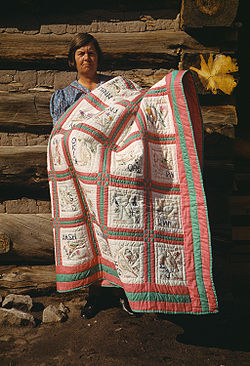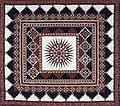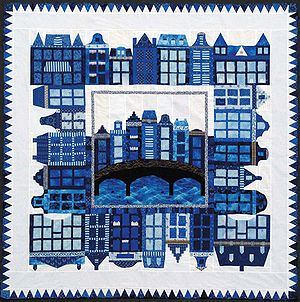
Patchwork quilt
Encyclopedia


Quilt
A quilt is a type of bed cover, traditionally composed of three layers of fiber: a woven cloth top, a layer of batting or wadding and a woven back, combined using the technique of quilting. “Quilting” refers to the technique of joining at least two fabric layers by stitches or ties...
in which the top layer consists of pieces of fabric
Textile
A textile or cloth is a flexible woven material consisting of a network of natural or artificial fibres often referred to as thread or yarn. Yarn is produced by spinning raw fibres of wool, flax, cotton, or other material to produce long strands...
sewn
Sewing
Sewing is the craft of fastening or attaching objects using stitches made with a needle and thread. Sewing is one of the oldest of the textile arts, arising in the Paleolithic era...
together to form a design. The quilting
Quilting
Quilting is a sewing method done to join two or more layers of material together to make a thicker padded material. A quilter is the name given to someone who works at quilting. Quilting can be done by hand, by sewing machine, or by a specialist longarm quilting system.The process of quilting uses...
design does not necessarily follow the patchwork
Patchwork
Patchwork or "pieced work" is a form of needlework that involves sewing together pieces of fabric into a larger design. The larger design is usually based on repeat patterns built up with different colored shapes. These shapes are carefully measured and cut, straight-sided, basic geometric shapes...
design, and the design of the quilting may play off the patchwork design.
Originally, this was to make full use of left-over scraps of fabric, but now fabric is often bought specially for a specific design. Fabrics are now often sold in quarter meters (or "yards" in the U.S.). (A "fat quarter" is one square meter folded into four and cut along the folds, thus giving a square piece of fabric 50 cm on a side, as opposed to buying a quarter of a meter off the roll, resulting in a long thin piece that is only 25 cm wide).
Designs can be geometric
Geometry
Geometry arose as the field of knowledge dealing with spatial relationships. Geometry was one of the two fields of pre-modern mathematics, the other being the study of numbers ....
and formal or imaginative. Patchwork blocks were initially created individually, accumulated over time, by use of scrap and salvaged material. Geometric designs were the most efficient way to aggregate fabric into useful units. Applique, where a piece of fabric is layered on top of the a base or "ground" fabric and then the cut edges are folded under and sewn down, is not limited to simple geometric designs. Early uses of applique in the United States included efforts to expand the effect of expensive, imported European fabrics in early America. The dense printed patterns were cut out, spread apart on a background of plain fabric, allowing the effect of the rare fabric to spread further. Broderie perse is a related techique, were selections of printed fabric are cut out, and sewn in place to produce the effect of a custom printed cloth. Reverse applique involves cutting the ground fabric, and placing another fabric beneath the opening. The raw, cut edges are folded under, and sewn onto the smaller piece of fabric below, creating a new design.
The quilt is formed of three layers: the patchwork, a layer of insulation wadding (batting
Batting (material)
Batting is a layer of insulation used in quilting between a top layer of patchwork and a bottom layer of backing material. Batting is usually made of cotton, polyester, and/or wool....
) and a layer of backing material. These three layers are stitched together ("quilted"), either by hand or machine. The quilting can either outline the patchwork motifs, or be a completely independent design. Additional design options is provided by quilting techniques that alter the texture of the quilt. These include: trapunto (where additional batting is stuffed into a descrete section of the quilting), cording (where cotton cording or yarn are pulled between quilting lines that form channels), and stipple quilting (were dense, closely spaced quilting causes the batting to be more compressed than it is in adjacent areas). Another, more casual option is to "tie" the quilt. Heavy thread or yarn is used to tie all three layers together at points across the surface of the quilt.
History
Quilting was a very popular early American pastime, particularly in the MidwestMidwestern United States
The Midwestern United States is one of the four U.S. geographic regions defined by the United States Census Bureau, providing an official definition of the American Midwest....
, where quilting circles were a common social pastime for women. Annual town fairs generally included a quilting bee, to award excellence in quilting. Handmade quilts were a very common wedding gift for young couples, and were often mentioned specifically in wills due to their sentimental significance. It was not uncommon, in early American culture, for quilts to reflect a mosaic of a woman's life, often including swatches of material from memorable events such as pieces of a wedding gown or a child's baptismal garment. The Amish
Amish
The Amish , sometimes referred to as Amish Mennonites, are a group of Christian church fellowships that form a subgroup of the Mennonite churches...
people are famous for their geometric patchwork designs with independent patterns and quilting; typical motifs include floral designs and heart shapes. The Amish and Mennonite
Mennonite
The Mennonites are a group of Christian Anabaptist denominations named after the Frisian Menno Simons , who, through his writings, articulated and thereby formalized the teachings of earlier Swiss founders...
women of the Pennsylvania Dutch
Pennsylvania Dutch
Pennsylvania Dutch refers to immigrants and their descendants from southwestern Germany and Switzerland who settled in Pennsylvania in the 17th and 18th centuries...
country have been creating exquisite quilted masterpieces since the mid-19th century (and some believe even earlier). Amish quilts are an expression of frugality. They not only serve a practical, functional purpose, but serve as a form of entertainment as well.
In 1987 in San Francisco, the Names Project commenced as a memorial to the lives of people who died from AIDS
AIDS
Acquired immune deficiency syndrome or acquired immunodeficiency syndrome is a disease of the human immune system caused by the human immunodeficiency virus...
and related diseases with quilt panels made by loved ones. Also known as the AIDS Quilt
NAMES Project AIDS Memorial Quilt
The NAMES Project AIDS Memorial Quilt, often abbreviated to AIDS Memorial Quilt, is an enormous quilt made as a memorial to and celebration of the lives of people who have died of AIDS-related causes...
, it grew to comprise many thousands of panels, and spawned similar projects in countries around the globe. In later years, other subject- and event-specific community-based quilts have been created.

Colorwash quilting
This non-traditional method of quilting uses small blocks of color to achieve the look of a watercolor painting where there is no fixed pattern. Fabrics are chosen for their hue and tone.Further reading
- Ferrero, Pat, Elaine Hedges, and Julie Silber. Hearts and Hands: The Influence of Women & Quilts on American Society. Rutledge Hill Press, Nashville, Tennessee, 1987.
- Hedges, Elaine, Pat Ferrero, and Julie Silber. Hearts and Hands: Women, Quilts, and American Society. Rutledge Hill Press, Nashville, Tennessee, 1996.
- Kiracofe, Roderick, and Mary Elizabeth Johnson. The American Quilt: A History of Cloth and Comfort 1750-1950, Clarkson N. Potter, Inc., New York, 1993.

